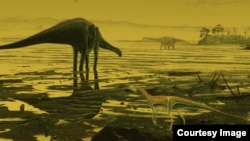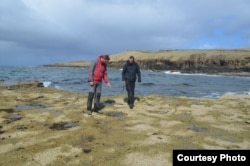A huge trove of dinosaur tracks discovered off the coast of Scotland offers a rare picture of the primitive ancestors of the long-necked, potbellied sauropods, the largest animals ever to walk the planet. Their massive footprints help fill in a gap in the evolutionary history of these behemoths.
For 135 million years, dinosaurs ruled the Earth as the dominant terrestrial vertebrates, from about 200 million years ago until the cataclysm that wiped them out 66 million years ago. Fossil hunters have been unearthing their bones for about 200 years.
Paleontologist Steve Brusatte of the University of Edinburgh’s School of GeoSciences stumbled upon what looked like huge potholes on Scotland's Isle of Skye.
“And they were big, the size of a trash can lid,” he said. “We noticed that there was a pattern to them. They had this zigzag shape in a line. And it dawned on us that these were the footprints of dinosaurs, of giant long-necked dinosaurs."
Until this discovery, described in the Scottish Journal of Geology, the only evidence that sauropods lived in Scotland came from a small number of bone and tooth fragments. Brusatte called the find "dumb luck." The fossilized tracks are largely hidden by the rising tide or covered with seaweed and sand during storms.
Thousands of tracks
Those same rock layers continue into the ocean, and also inland.
“So if we could see the entire thing, we are probably talking about thousands and thousands of tracks,” Brusatte said.
The layers represent three different time periods in the mid-Jurassic period, about 170 million years ago. The tracks add to the evolutionary history of the long-necked, plant-eating sauropods. They clearly show that these dinosaur giants were active on land, but also got their feet wet — either to feed or to hide from predators.
The prints were found on the bottom of what was once a shallow saltwater lagoon. Brusatte said only the biggest of the big dinosaurs, ancestors of the well-known Brontosaurus and Diplodocus, could have left those tracks.
“We see in some of the better-preserved ones the individual fingers and the toes," he said. "We can see where the claws are. We can see the shape of the foot that left the track, and all of those things can be matched very closely to the skeletons of these big, long-necked dinosaurs.”
With the recent discovery, the search for more insight into our planet's ancient past has gained energy. Brusatte said scientists can never really predict what they're going to find, "but I think that there is a whole lot of excitement out there.”













